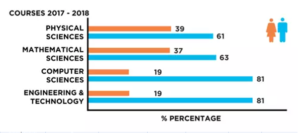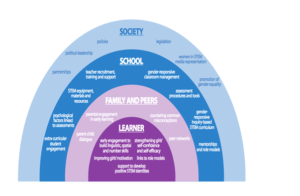We know of Marie Curie, the first Woman to win a Nobel Prize in Physics with remarkable achievements in the field of science. However, the unknown fact that since 1903 only 53 women have won this award and among them, only 20 women have won it in the field of medicine, physiology, chemistry and physics is astonishing.[1] Joan Clarke, the only woman in the exceptional team of codebreakers who decoded Enigma during the World War 2, was although highly respected for her commendable work but fell short in comparison to Bletchley Park exemplar- Alan Turing, who punished by a post-war society for homosexuality (a crime in that era). History has treated homosexuality with more kindness than sexism which is a defiant proof of inequality. Consequently, most of us are unaware of Dr. Asima Chatterjee, the first woman to receive ‘Doctorate of science’ from an Indian university or A. Lalitha, the first woman engineer of our country. When comes the question of pursuing a career in science, the deep-rooted patriarchy in our society holds women back, even today.
The underrepresentation of women employed in the STEM (Science, Technology, Engineering and Mathematics) field is a matter of concern especially in today’s time. Many scholars, researchers and policymakers have witnessed these fields to be predominantly occupied by males with historically lower participation by their female counterparts. This raises some complex questions about the relationship of gender with technology and development and there is consensus that the causes are socio-cultural factors as opposed to biology or genetics.
Feminism is largely defined as the belief in social, economic, and political equality of the sexes. But the question arises, why is Mathematics, a feminist issue? The answer lies in the fact that all the previous studies tackling gender differences in mathematics proceeded from the assumption that we could segregate the “successful” (in math) from the “unsuccessful” thereby isolating the causes for the differences. After this it was assumed that we could change the characteristics of those who are “unsuccessful” by eliminating the causes, in turn making them “successful”. This approach wasn’t incorrect except the fact that in general, it is males who are more successful in mathematics than females. Therefore, the solution to sexism in mathematics becomes making females more like males. It assumes that gender is not a salient variable in determining behavior and is easily modifiable. It also declares that males are the norm; how they do things is the only way of doing things and that the road to success is to behave as males behave. This approach conforms to male superiority that feminists across the globe have been questioning and fighting since ages.
Sometimes, it is claimed that the poor representation of women in STEM career is nothing abnormal because the fact of life is that men and women are different. But literature shows that even though there are biological differences between men and women they are not correlated to their scientific or mathematical ability. These differences are not enough to explain the under-representation of women in STEM careers.
Sex is defined as the biological attributes that make someone male or female. Characteristics caused by sex are intrinsic. Gender, however, is classified by the properties that identify an individual as a man or a woman. Gender is different from sex in that it is not inherent,but is learned. Gender identification is influenced by societal factors, while sex is based solely on biological characteristics. For the purpose of our argument, gender is particularly important, because it is the combination of the biological and societal factors that is responsible for affecting women’s career decision and not sex. An EEG (electroencephalogram) study showed that men and women approach spatial tasks very differently. Male brains perform more asymmetrically, meaning that they use the right hemisphere of their brain while female brains access both hemispheres equally when performing spatial tasks. Despite the differences in brain cell functions, one must remember that it is unknown to what degree the differences in brain function are caused by biological factors or by sociocultural factors, and that it is likely cultural factors, combined with brain differences, that are responsible for these large discrepancies in gender performance.
According to the report of National Task Force for Women in Science, only 15% of the Indian research and development workforce are women, while the global average is 30%.[2] The imbalance is biggest in fields such as computer science and physics, and smallest in life sciences and medicine. This trend starts from the graduation level. As per All India Higher Education Survey (AIHES) 2017-18, while 49% female students are enrolled in B.SC, this figure is as low as 29% for B.Tech. The gender disparity becomes more prominent when it comes to students opting for Ph.D., with only 6% women in Engineering and Technology courses opting for Ph.D. after their post-graduation.[3]
While 40% of Indians graduating from STEM are women, we as a country aren’t gaining much from it. Women constitute only 14% of the total scientists, engineers and technologists in research development institutions in India, despite women centric initiatives. While girls enrolling in fields of STEM are increasing, the number of women entering workplace isn’t increasing proportionately. Only 35% stem students are women. India becomes a paradox as it has graduates but not researchers. [4]

Source: www.stemwomen.co.uk
The figure above shows the student enrolment in different courses in UK
These stats again point to the same question- “Why is there such a discrepancy?” Several studies have noted the impact of background stereotypes. The researchers found that numerous studies claiming that the stereotype, “Men are better at math” is believed to undermine women’s math performance.[5] Women and girls may therefore experience stereotype threat. Over time this can lead to “disidentification,” where individuals lose aspirations for fields they are stereotyped against. Another effect acts through men and boys where a dominant “men must not cry” sometimes results in emotional unavailability. Stereotype threat is a particular kind of identity contingency that puts us under constant pressure because we are being constantly judged on what degree we abide by or deviate from stereotypes about our identity. Numerous studies have revealed how important is to recognize the effects of stereotype threat because of how strongly it can affect women’s math performances.
Women have been consistently underrepresented in many math and science fields due to both perceived biological and cultural factors. Factors like family decisions, financial considerations, workplace cultures and discrimination can shape their respective careers in STEM fields. However, we are witnessing a dynamic shift in the larger corporations slowly but the ground level reality hasn’t changed much. Numerous studies have found that women in STEM fields publish less, are paid less for their research and do not progress as far as men in their careers. However, there is very little data at the international or even country level showing the extent of these disparities.
In conclusion, characterization by gender reinforces conformity, while what is needed is an appreciation of diversity. A revolution is required not only on a societal level but also on an individual level. Stereotype threat needs to be acknowledged and tackled to bring about a change in the way women in STEM fields are being perceived by society in general.

We require a dedicated strategy not only for increasing the representation of women in the STEM jobs but also for ensuring that they thrive, incentivizing them to remain in these high-paying jobs and establishing cultures that enable women to advance in these fields.
References
[1] Nobel Prize awarded women. NobelPrize.org. Nobel Media AB 2020. 31 Jul 2020. <https://www.nobelprize.org/prizes/lists/nobel-prize-awarded-women>
[2]National Task Force for Women in Science, Government of India, Evaluating and Enhancing Women’s participation in Scientific and Technological research: The Indian Initiative, 2009 p.12
[3] Ministry of human resource development, Department of Higher Education, New Delhi 2018, All India Survey on Higher Education 2017-18 (section 2.2)
[4] India tops the world in producing female graduates in STEM but ranks 19th in employing them. Prerna Sindwani. 31 July, 2020. <https://www.businessinsider.in/careers/news/india-tops-the-world-in-producing-female-graduates-in-stem-but-ranks-19th-in-employing-them/articleshow/74117413.cms>
[5] University of Missouri-Columbia. “‘Women worse at math than men’ explanation scientifically incorrect, experts say.” ScienceDaily. ScienceDaily, 18 January 2012. <https://www.sciencedaily.com/releases/2012/01/120118123141.htm>






